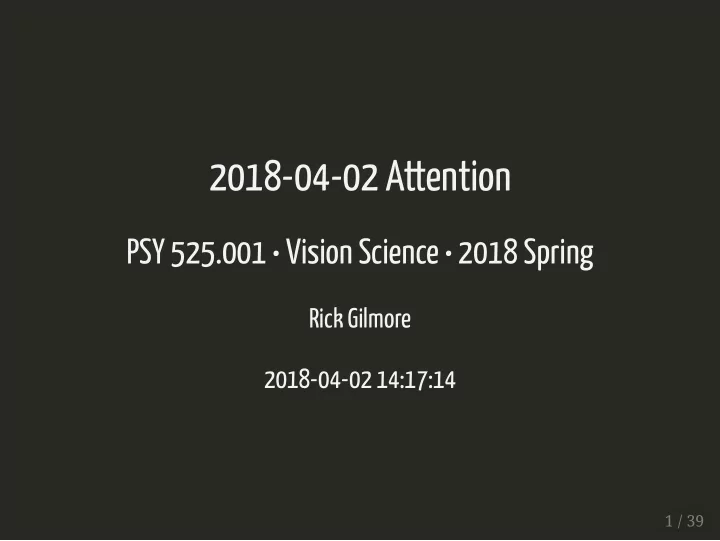

2018-04-02 Attention PSY 525.001 • Vision Science • 2018 Spring Rick Gilmore 2018-04-02 14:17:14 1 / 39
2 / 39
Today's topics 3 / 39
Today's topics Scheduling student presentations 3 / 39
Today's topics Scheduling student presentations Attention 3 / 39
" Everyone knows what attention is. It is taking possession of the mind, in clear and vivid form, of one out of what seems several simultaneously possible objects or trains of thought. Focalization, concentration of consciousness are of its essence. It implies a withdrawal from some things in order to deal effectively with others. " William James 4 / 39
5 / 39
6 / 39
Capacity limits on processing => Requires recruitment & focusing of resources 7 / 39
When does information get selected? Early vs. Late Attention as '�lter' (Broadbent's shadowing experiments) 8 / 39
Stimulating in 'unattended' areas 'Inattentional blindness' or perception without attention Rock, I., Linnett, C. M., Grant, P., & Mack, A. (1992). Perception without attention: Results of a new method. Cognitive Psychology , 24 (4), 502–534. Elsevier. Retrieved from https://www.ncbi.nlm.nih.gov/pubmed/1473333 9 / 39
Rock et al., 1992 10 / 39
Rock et al., 1992 11 / 39
Evidence for 'late' selection: personal relevance, emotional intensity, etc. Task load and selection: high 'early', low 'late' (Lavie) 12 / 39
Temporal factors Attentional 'blink' 13 / 39
Rapid Serial Visual Presentation (RSVP) task 14 / 39
Change blindness 15 / 39
16 / 39
17 / 39
'Cueing' attention 18 / 39
By Local870 (talk) (Uploads) - Local870 (talk) (Uploads), CC BY 3.0, Link 19 / 39
Posner cueing task Quantifying the (RT) costs and bene�ts of attention 20 / 39
Feldman, H., & Friston, K. J. (2010). Attention, uncertainty, and free-energy. Frontiers in Human Neuroscience , 4, 215. frontiersin.org. Retrieved from http://dx.doi.org/10.3389/fnhum.2010.00215 21 / 39
Spotlight (move/enhance/disengage) vs. Zoom lens 22 / 39
Object-based attention 23 / 39
Vecera, S. P., & Behrmann, M. (2001). 6 - Attention and Unit Formation: A Biased Competition Account of Object-Based Attention. In T. F. Shipley & P. J. Kellman (Eds.), Advances in Psychology (Vol. 130, pp. 145–180). North-Holland. Retrieved from 24 / 39 http://www.sciencedirect.com/science/article/pii/S0166411501800261
Attention to properties/dimensions 25 / 39
Stroop, J. R. (1935). Studies of interference in serial verbal reactions. Journal of Experimental Psychology , 18(6), 643. Psychological Review Company. Retrieved from http://psycnet.apa.org/record/1936-01863-001 26 / 39
Break 27 / 39
Treisman, A. M., & Gelade, G. (1980). A feature-integration theory of attention. Cognitive Psychology , 12 (1), 97–136. Elsevier. Retrieved from https://www.ncbi.nlm.nih.gov/pubmed/7351125 28 / 39
29 / 39
Integral vs. separable dimensions (Garner) 30 / 39
Separable: color vs. shape Integral: color saturation and lightness; length & height 31 / 39
Pop-out 32 / 39
Tachistoscope 33 / 39
34 / 39
Why are search slopes for single features '�at' as the number of items increases? 34 / 39
Why are search slopes for single features '�at' as the number of items increases? Why are search slopes for 'negative' (conjunction target not present) conditions ~2x those for 'positive' (conjunction target present) conditions? 34 / 39
Simons, D. J., & Chabris, C. F. (1999). Gorillas in our midst: Sustained inattentional blindness for dynamic events. Perception , 28 (9), 1059–1074. Retrieved from http://dx.doi.org/10.1068/p281059 35 / 39
36 / 39
Neisser, U., & Becklen, R. (1975). Selective looking: Attending to visually specified events. Cognitive Psychology , 7 (4), 480–494. Elsevier. Retrieved from http://www.sciencedirect.com/science/article/pii/0010028575900195 37 / 39
Becklen, R., & Cervone, D. (1983). Selective looking and the noticing of unexpected events. Memory & Cognition , 11 (6), 601–608. Retrieved from https://www.ncbi.nlm.nih.gov/pubmed/6669028 38 / 39
Slides created via the R package xaringan . Rendered HTML and supporting files are pushed to GitHub where GitHub's 'pages' feature is used to host and serve the course website. 39 / 39
Recommend
More recommend